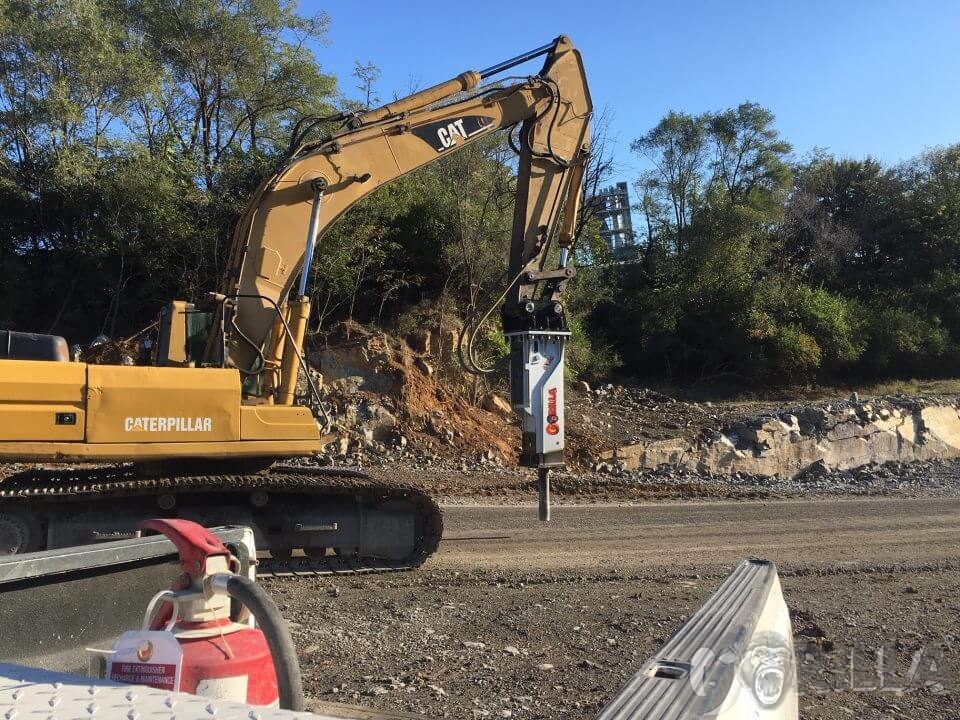Ingersoll-Rand Acquires United States Distribution Rights For Tramac Branded Hydraulic Breakers
April 23, 2018Scrap Recyclers & Demolition Contractors Relying On Hydraulic Processing Attachments
April 23, 2018Construction & Demolition Recycling, March-April, 2005 by Jackie Gubeno
As the concrete recycling industry grows, breakers and hammers are becoming more and more important on job sites. With many companies choosing to recycle concrete on site, breakers have become an integral part of many recycling operations, as well as popular tools for demolition contractors.
Recyclers rely on breakers and hammers to size slabs of concrete down to fit into crushers for the aggregate market as well as to separate steel from concrete structures for the booming steel scrap market.
Whether used for sizing or separating, breaker attachments continue to play an important role in the changing demolition debris and concrete recycling industries.
MATCHMAKING
Most breakers and hammers can be attached to a variety of carriers, which adds to the versatility and usefulness of the work tools, says Ryan Murphy, director of marketing for Indeco North America, a manufacturer of hydraulic demolition attachments headquartered in Stratford, Conn. “Carriers run the whole gamut–skid steers, excavators, backhoes and loaders,” he says.
In addition to its more traditional role in concrete demolition, a breaker (or hydraulic hammer) can also be used in the demolition of other hard material, like refractory brick, says Gary Hesseltine, vice president of marketing for Tramac Corp., Parsippany, N.J.
Craig Nelson, president of mechanical impact hammer manufacturer Surestrike International Inc., Luck, Wis., says breakers and hammers also separate rebar from concrete.
Some smaller breakers can also be equipped with tooling for asphalt cutting, or for applications outside the demolition industry like rock excavation, soil compaction and post driving, says Kevin Loomis, hydraulic applications manager for Atlas Copco Construction Tools, headquartered in Springfield, Mass.
But with the versatility that numerous carrier options afford, a recycler has many factors to consider when sizing a breaker or hammer to a particular machine.
To assure that carrier and attachment will be well balanced and to reduce the risk of tipping, Loomis says one must strictly adhere to carrier weight recommendations.
The manufacturer is the operator’s best resource when matching a breaker or hammer to a carrier, says Frank Smith, president of drop hammer manufacturer Universal Impact Technology Inc., headquartered in Cumming, Ga.
“You have to make sure the carrier is E sufficient to handle the weight of the attachment itself, both when it’s operating and when it’s transporting,” Smith says. “The biggest thing is the contractor needs ‘t to follow the rules of what the manufacturer asks him to do.”
Also, just as important is the ability of the carrier to hold the breaker down, Murphy says. He says that some carriers, excavators in particular, have added counterweight to give them a heavier lift capacity. “But putting extra weight on can impede its ability to hold the breaker down,” he says. “Then the power that’s going through isn’t going directly through the material.”
Hydraulic input should also be considered in conjunction with the set up of a hydraulic breaker, Loomis says. “Choosing the largest possible breaker that your carrier can hold provides less of a benefit if the carrier can not hydraulically operate the breaker to maximum performance levels,” he says.
Loomis says maximum weight specifications aren’t the only consideration when sizing a breaker to a carrier.
“Hydraulic input values under the breaker’s minimum requirements can be as damaging as exceeding maximum values,” he says. “The published input specifications for all hydraulic attachments are listed for a reason, and operating outside of these parameters will likely yield problems.”
UPKEEP
Once a breaker is properly fixed to its carrier, recyclers can take several steps to ensure the tool works to its maximum potential. “Hydraulic breaker maintenance is surprisingly minimal, but necessary for a long and profitable relationship with your attachment,” says Loomis.
The equipment maker is the best guide for maintenance requirements, Smith says. “Different hammers have different maintenance requirements,” he says.
Though basic, manufacturers and suppliers agree that regular lubrication is the most important part of the hydraulic breaker’s basic maintenance.
“You’re talking about metal-on-metal contact,” says Murphy. “Without the grease, you start creating heat, and that’s when you start experiencing failure.”
Watching wear parts also helps to extend a breaker’s lifespan, Loomis says. “Routine checks of bushing and tool wear will thwart exaggerated repair bills bycatchinga problem before catastrophic damage can occur.”
Other basic maintenance includes keeping the tool in line and making sure all the axels and pins are in place, says Murphy. “If the wear parts are monitored and the grease is good, then you should be able to run a breaker without failure,” he says.
BREAKING NEWS
The trend toward controlled demolition in North America has changed the way a lot of equipment is used on the jobsite, including breakers and hammers.
“Disassembling buildings and recycling debris has made hydraulic breakers a must on any demolition job,” Loomis says. “With a breaker, you can be more selective regarding the removal of building material as compared with traditional blasting methods.”
Breakers also also useful for procressing in the middle of structures or environments that are still in use, Loomis says.
But as the trend continues to shift away from cranes, wrecking balls and blasting, hydraulic breakers and hammers can come under increasing pressure from other controlled demolition attachments.
“Controlled demolition has created a market for new, more precise demo tools that breakers compete with,” Murphy says. While hydraulic breakers and hammers have the advantage against older, less selective methods of demolition, they are under constant competitive pressure to become more controlled, he says.
Several developments have helped breakers and hammers work better. Murphy says a number of companies, Indeco included, have developed “whisper versions,” or quieter models with sound-dampening systems or enclosed housing that can be used on jobsites that might be under municipal noise regulations. “It can be the difference between working one shift or two,” he says.
Demolition workers, not just people surrounding the work area, appreciate the quieter hammers, says Smith. Controlled demolition has people working more closely to the equipment, making noise and dust control important safety features, he says.
The development of variable hammers has also improved the attachment, says Hesseltine. “Different materials break better with a different techniques,” he says. “Variable hammers give the right combination of frequency and impact for a given material.”
Because lubrication is one of the most importance maintenance features, many recent models are equipped with built-in lubrication systems, Hesseltine says.
Loomis says, “This takes the responsibility out of the operator’s hands for routine greasing while allowing the lubricator to stay with the attachment.”
Also, some models come with a safety feature that keeps the tool from firing if there’s no resistance, Hesseltine says.
“It’s dangerous to engage in dry firing or blank firing–when the breaker is firing with full force, but not being pushed up against anything,” he says. “It’s not good for the front part of the breaker.”
Some recent models come with blank firing protection so the breaker won’t fire in the absence of pressure. Or, Hesseltine says, some models will reduce the force if there’s no resistance, like when a breaker or hammer breaks through the wall it’s demolishing.
Murphy says these subtle changes to the hydraulic breaker have helped the tool become one of the demolition industry’s most versatile attachments. CD&R
The author is the assistant editor of Construction & Demolition Recycling and can be contacted at jgubeno@gie.net.
COPYRIGHT 2005 G.I.E. Media, Inc. COPYRIGHT 2005 Gale Group



